Herbs are some of the best crops to grow if you want to save money and slash your grocery bills. Both fresh and dried herbs can be pricey, but if you learn how to dry herbs at home, you can enjoy your garden harvest throughout the seasons and even craft your own herbal teas and seasoning blends. But the catch is that some herbs dry beautifully in bundles with hang drying, while other herbs preserve best with quick-drying methods.
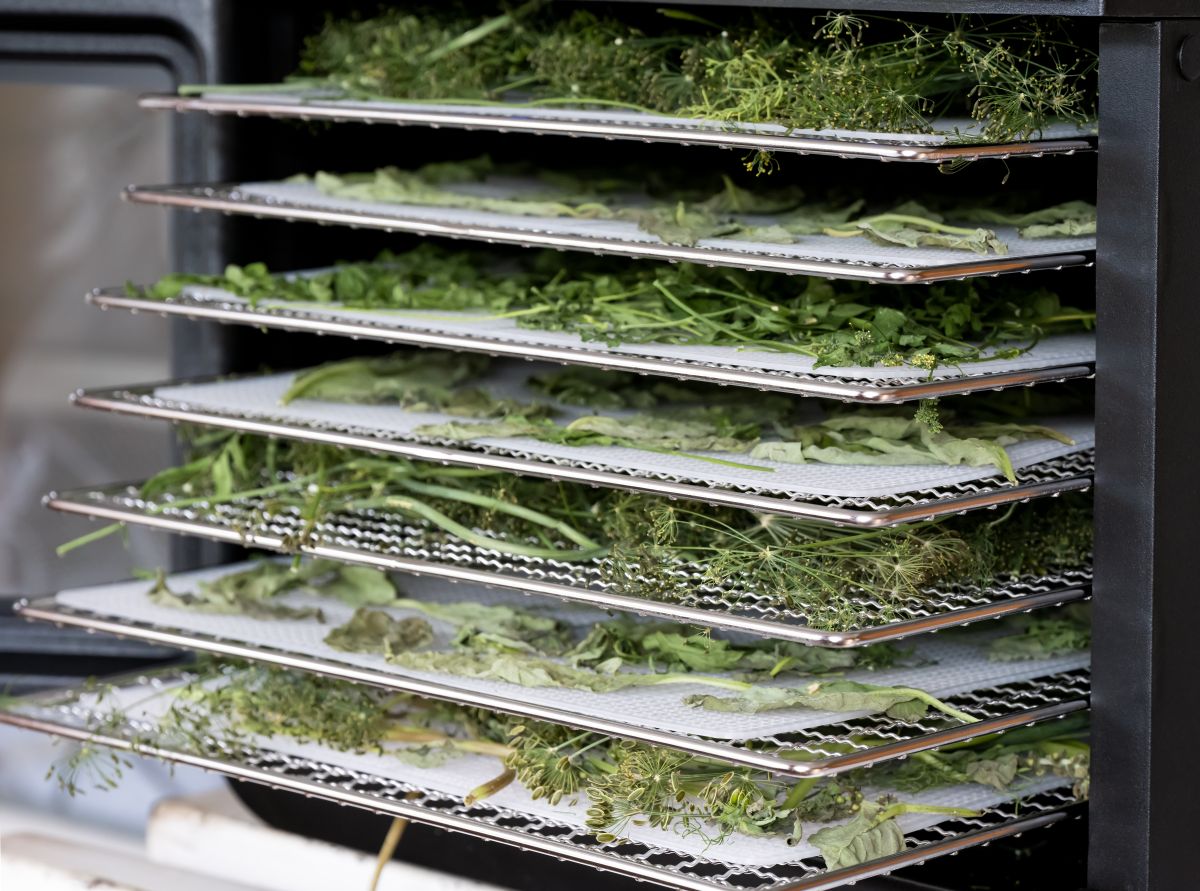
Food dehydrators, microwaves, and ovens set on the lowest heat setting can all be used to dehydrate fresh herbs and preserve them for winter. Herbs with fleshy stems and high moisture contents tend to dry best with quick dehydration, while woody-stemmed herbs lend themselves well to hang drying. In this guide, you’ll discover the best herbs to dry with a dehydrator or an oven, and we’ll also provide some drying tips to get you started preserving homegrown herbs.
Jump to:
- 10 best herbs to dry with a dehydrator or oven
- 1. Basil (Ocimum basilicum)
- 2. Lemon balm (Melissa officinalis)
- 3. Oregano (Origanum vulgare)
- 4. Mint (Mentha spp.)
- 5. Tarragon (Artemisia dracunculus)
- 6. Cilantro (Coriandrum sativum)
- 7. Chives (Allium schoenoprasum)
- 8. Shiso (Perilla frutescens var. crispa)
- 9. Celery leaves (Apium graveolens)
- 10. Chervil (Anthriscus cerefolium)
- Frequently asked questions
- Summary
10 best herbs to dry with a dehydrator or oven
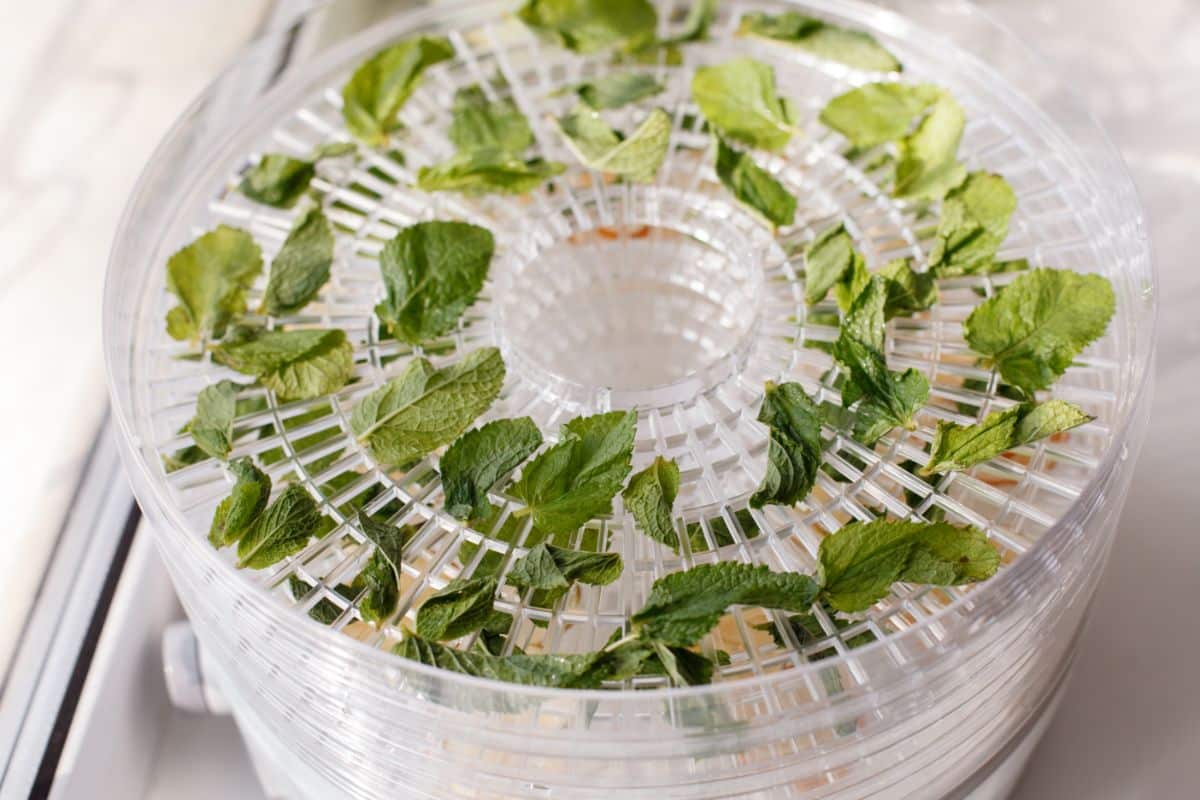
Dehydrating herbs with a dehydrator streamlines the herb drying process and can provide you with thoroughly dried herbs in just a few hours. While hang-drying herbs have their aesthetic appeal, it’s hard to argue with the efficiency of dehydrators! Even woody-stemmed herbs can be dried with dehydrators; however, the herbs listed below should always be dried as quickly as possible to preserve their color and flavor.
1. Basil (Ocimum basilicum)
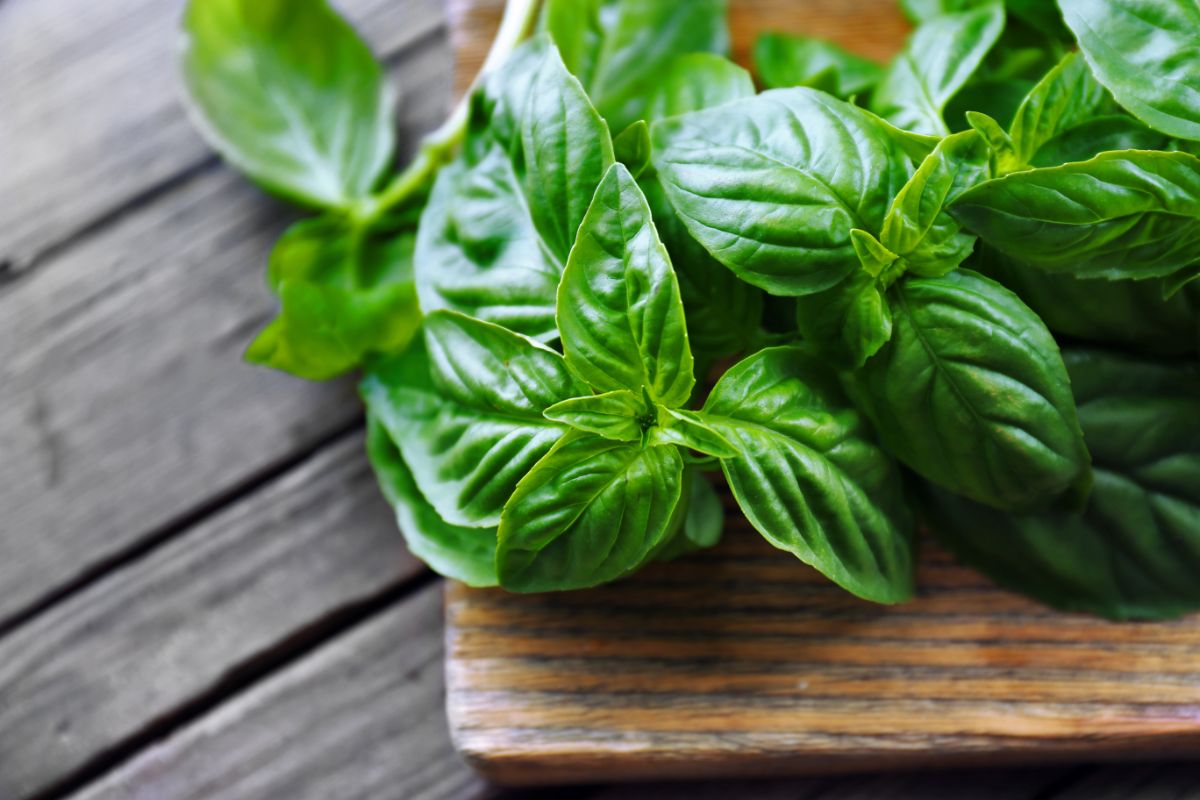
| Plant name: | Basil |
| Light requirements: | Full sun to light shade |
| Water requirements: | Moderate |
| Dehydrator temperature setting: | 95 to 110ºF |
| Remove stems before dehydrating? | Yes |
Basil is, hands down, one of the most popular herbs to grow at home, and its small size allows basil to be grown in pots or garden beds. Pasta sauces, pizzas, and Caprese salads would be lost without fresh basil, but basil also dries beautifully, and preserving your harvest will allow you to savor this delicious herb throughout the winter months. But basil does have fleshy and tender leaves and stems, which means this herb needs to be dried quickly to preserve its color and flavor.
To dry basil with a dehydrator, rinse off your basil leaves and then pinch the leaves off the plant’s stem. Spread the basil leaves on a single layer on a drying rack and then dehydrate the leaves at 95 to 110ºF for a few hours. Your basil leaves will be fully dried and ready for storage when they can be easily crumbled between your fingers.
2. Lemon balm (Melissa officinalis)
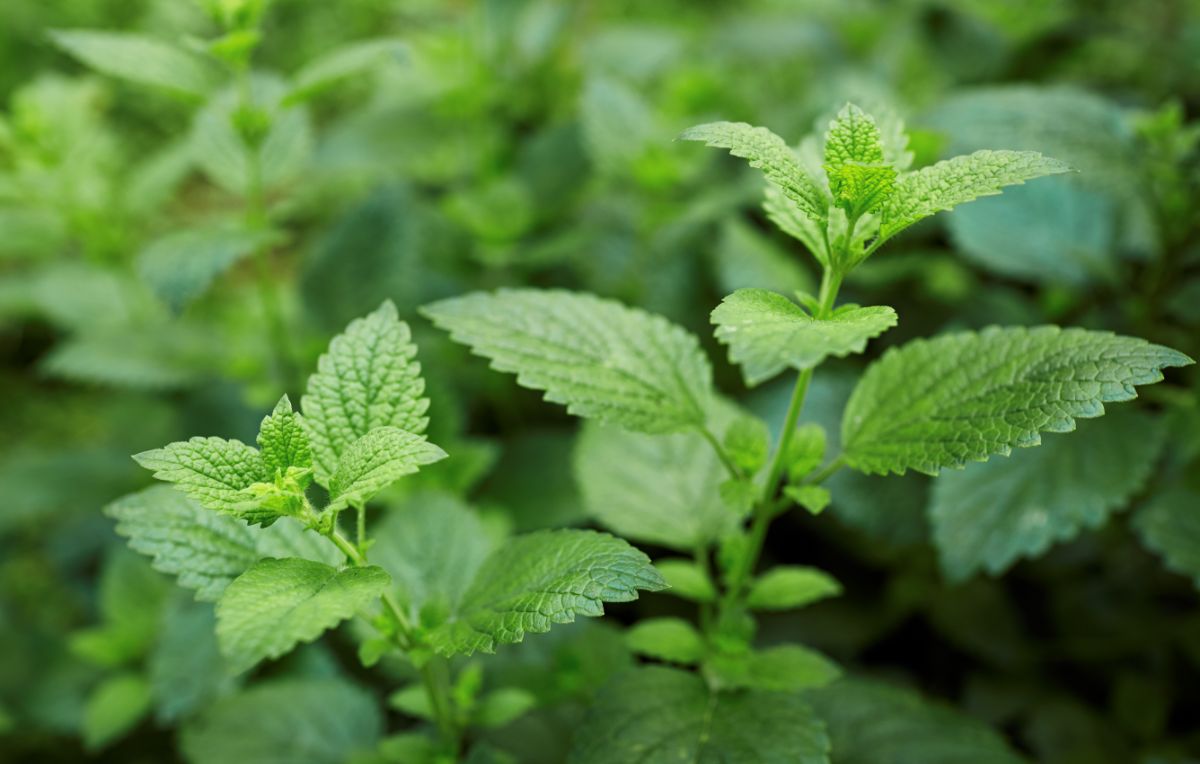
| Plant name: | Lemon balm |
| Light requirements: | Full sun to light shade |
| Water requirements: | Moderate |
| Dehydrator temperature setting: | 95 to 115ºF |
| Remove stems before dehydrating? | Optional |
Lemon balm tastes like springtime with its bright green leaves and delicate, lemony flavor. A favorite herb to use in herbal teas, lemon balm can also be mixed into desserts, jams, jellies, and other sweet confections. Plus, since it’s a member of the mint family, lemon balm is super easy to grow, and it grows so rapidly you may want to keep it in pots to prevent it from taking over!
Because lemon balm grows so quickly, most gardeners end up with more fresh lemon balm leaves than they can use. But if you don’t want to let all those delicious leaves go to waste, you can always dry them. Lemon balm is another plant that contains a lot of water, so it dries best in a dehydrator, and it will dry even better if you remove the plant’s stems before drying!
3. Oregano (Origanum vulgare)
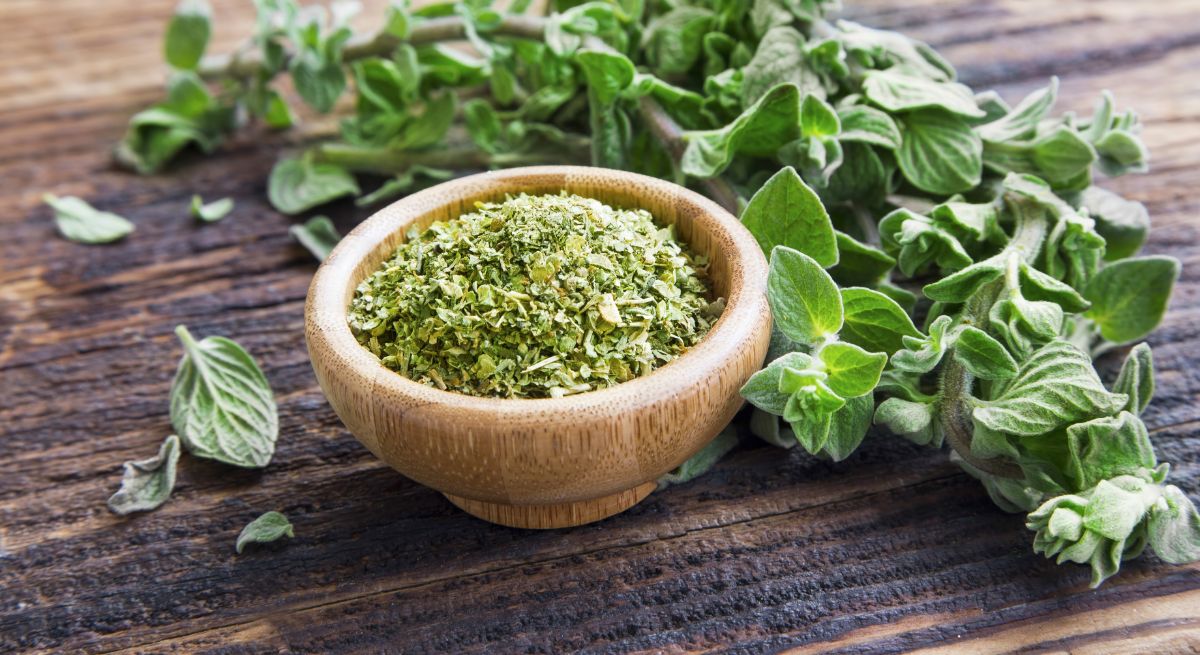
| Plant name: | Oregano |
| Light requirements: | Full sun |
| Water requirements: | Moderate to low |
| Dehydrator temperature setting: | 95 to 125ºF |
| Remove stems before dehydrating? | Optional |
Another must-have herb if you love pasta and homemade sauces, oregano is easy to keep in garden beds or pots, depending on our available growing space. One perk of oregano growing is that this herb is so incredibly cold-hardy that it often stays evergreen even in the depths of winter. Harvesting oregano leaves throughout the season encourages plants to produce new growth; however, you can also pick a larger harvest of oregano at the end of the season for drying.
While oregano has slightly woody stems, this plant is another good candidate for dehydrating since the plant’s leaves are not firmly attached to their stems, and oregano often drops leaves and makes a mess when hang dried. Oregano should be dehydrated at temperatures ranging between 95 to 125ºF, and you can leave the plant’s stems on or clip them off. Lower drying temperatures usually result in a higher quality dried herb, but higher temperatures help your herbs dry much faster!
4. Mint (Mentha spp.)
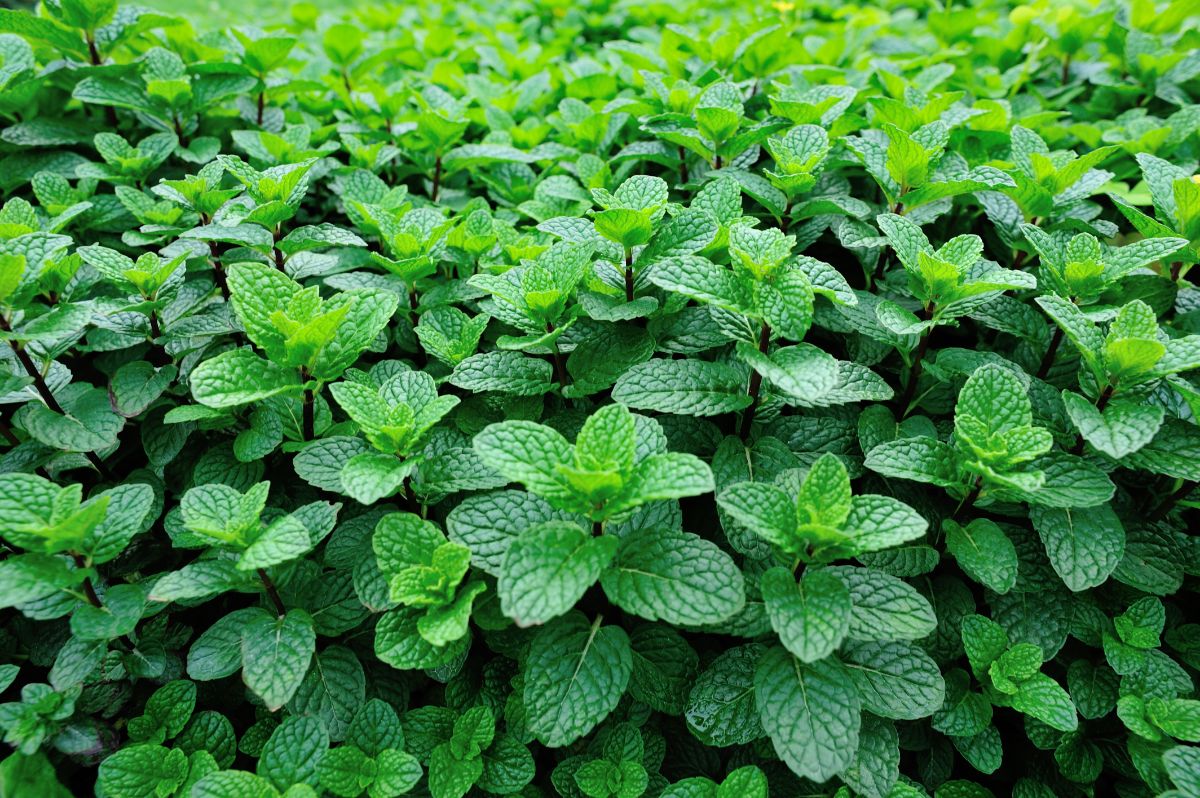
| Plant name: | Mint |
| Light requirements: | Full sun to light shade |
| Water requirements: | Moderate |
| Dehydrator temperature setting: | 95 to 115ºF |
| Remove stems before dehydrating? | Optional |
Zingy and flavorful mint make an unexpected addition to salads, but it’s also commonly brewed into herbal teas and baked into desserts and candies. Growing our own mint is the best way to have fresh herbs on hand whenever you need them, and homegrown mint is much more budget-friendly than any herbs you’ll pick up at the grocery store. As with lemon balm, home growers usually keep mint in pots as it can spread vigorously, but this plant is otherwise easygoing and great for beginners!
Mint leaves have a high moisture content, so they need to be dried quickly to maintain their flavor and to avoid them becoming soggy, brown, or moldy. Mint and other fresh herbs can be dried in a dehydrator or an oven set at the lowest heat setting; however, dehydrators tend to produce more reliable results. Most ovens run a bit too hot for drying herbs, which is why you’ll want to keep a close eye on your mint if you decide to dehydrate it in your oven!
5. Tarragon (Artemisia dracunculus)

| Plant name: | Tarragon |
| Light requirements: | Full sun to light shade |
| Water requirements: | Moderate |
| Dehydrator temperature setting: | 95 to 115ºF |
| Remove stems before dehydrating? | Optional |
A perfect complement to seafood, tarragon also makes a delicious addition to poached eggs, and it can be worked into homemade herbal butter too. Growing perennially in zones 4 and up, tarragon is a relatively easy plant to keep, and it will provide tasty leaves and colorful, edible flowers for your dinner table too! Tarragon does have a slightly licorice-like flavor, which may not be for everyone, but if you love the taste, tarragon is a must-have!
Tarragon can be dried with or without the stems, and if you dry this plant at 95ºF, it should take about 4 to 6 hours to finish drying, although drying times may vary depending on your dehydrator. After drying, herbs like tarragon can either be stored whole, or they can be ground and added to spice jars to make them even handier to use. Just keep in mind that herbs will lose their flavor a bit quicker if you grind them before storing.
6. Cilantro (Coriandrum sativum)
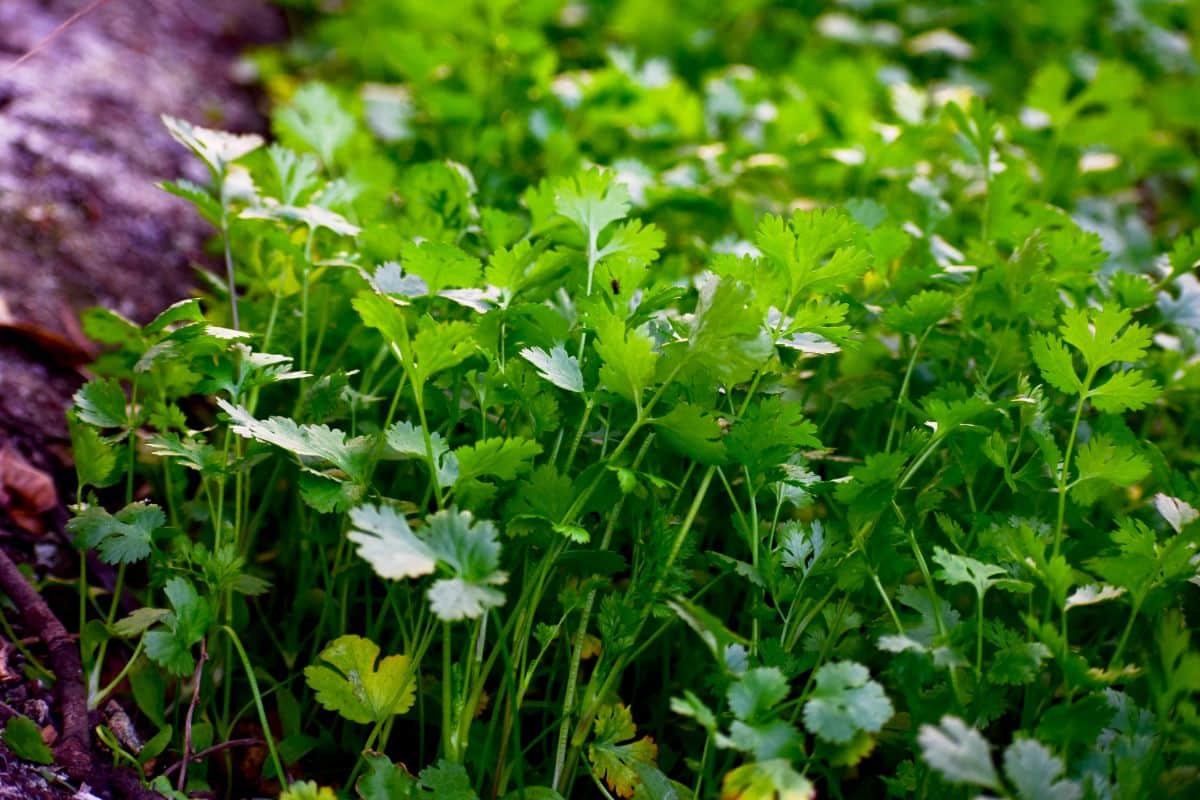
| Plant name: | Cilantro |
| Light requirements: | Full sun to light shade |
| Water requirements: | High to moderate |
| Dehydrator temperature setting: | 95 to 115ºF |
| Remove stems before dehydrating? | Optional |
A quintessential ingredient for salsa making and tacos, cilantro is a fast-growing herb that sprouts quickly from seed, no matter if you grow it in pots or garden beds. Since cilantro tends to bolt in the heat, most gardeners grow cilantro in spring and fall and stop growing this plant in summer to avoid bolting. However, if you have a lot of cilantro that needs to be preserved quickly or you want to harvest your plants before they bolt, dehydrating cilantro is always a good option.
In the garden, cilantro craves lots of water, and that translates into the plant’s fleshy and moisture-filled stems. Since cilantro contains so much water, it is not a good candidate for hang drying, but it does dry well in dehydrators or microwaves. To dry herbs in microwaves, sandwich herb leaves in a single layer between two paper towels and then microwave the herb for 15-second intervals until it is dry and crispy.
7. Chives (Allium schoenoprasum)
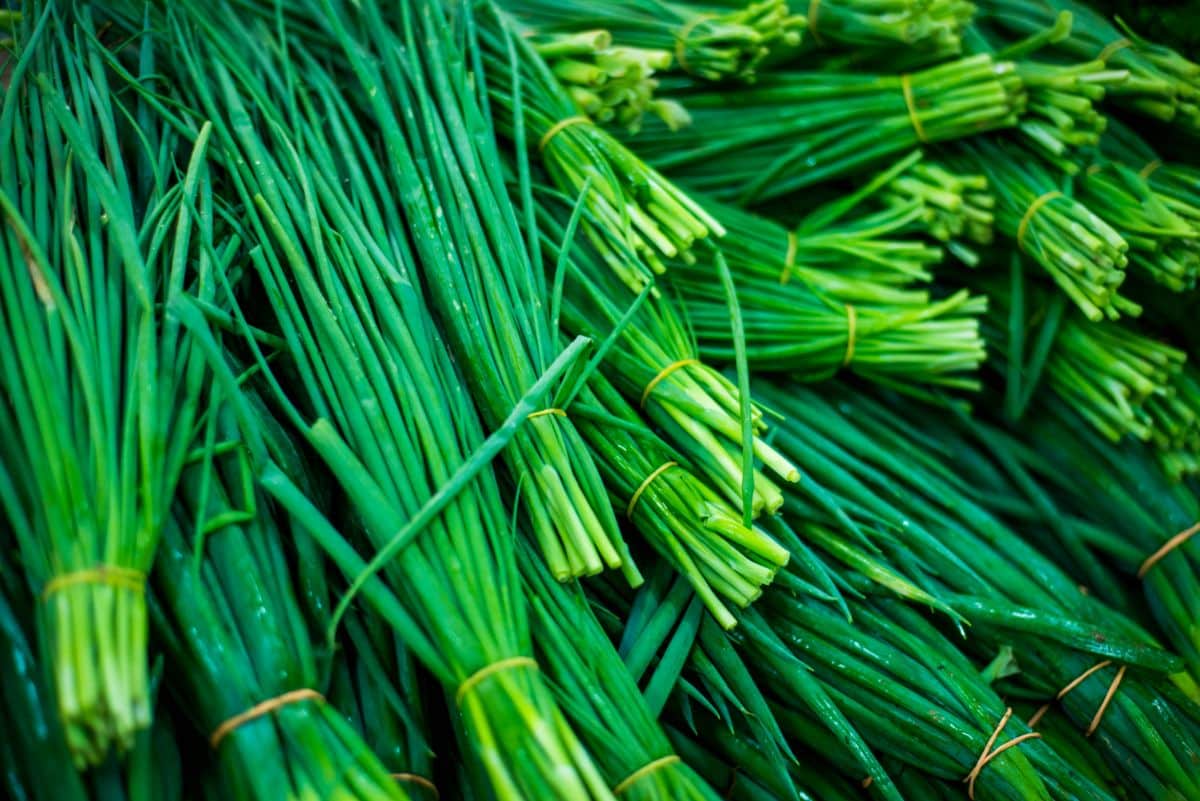
| Plant name: | Chives |
| Light requirements: | Full sun to light shade |
| Water requirements: | Moderate |
| Dehydrator temperature setting: | 95 to 105ºF |
| Remove stems before dehydrating? | N/A |
Baked potatoes aren’t complete without a nice helping of chopped chives, but chives are so versatile they can be used in tons of other dishes too, including soups, sautés and salads. At the end of the season, fresh herbs like chives can be stored in your freezer in airtight bags, or they can be chopped and frozen in ice cube trays, but it’s often even more convenient to dry and store chives in your spice cabinet! Depending on your cooking style, you can dry chives hole, or you can slice them into small rounds, but either way, these herbs will dry well in ovens, dehydrators, or microwaves.
After drying, chives can be ground into a fine powder and sprinkled into dishes or used to make a homemade vegetable stock. Dried, sliced chives are also a scrumptious condiment, and they can be added to many different dishes for extra color and flavor. Just remember to store dried herbs like chives in airtight containers and keep them out of direct light to preserve their shelf life!
8. Shiso (Perilla frutescens var. crispa)
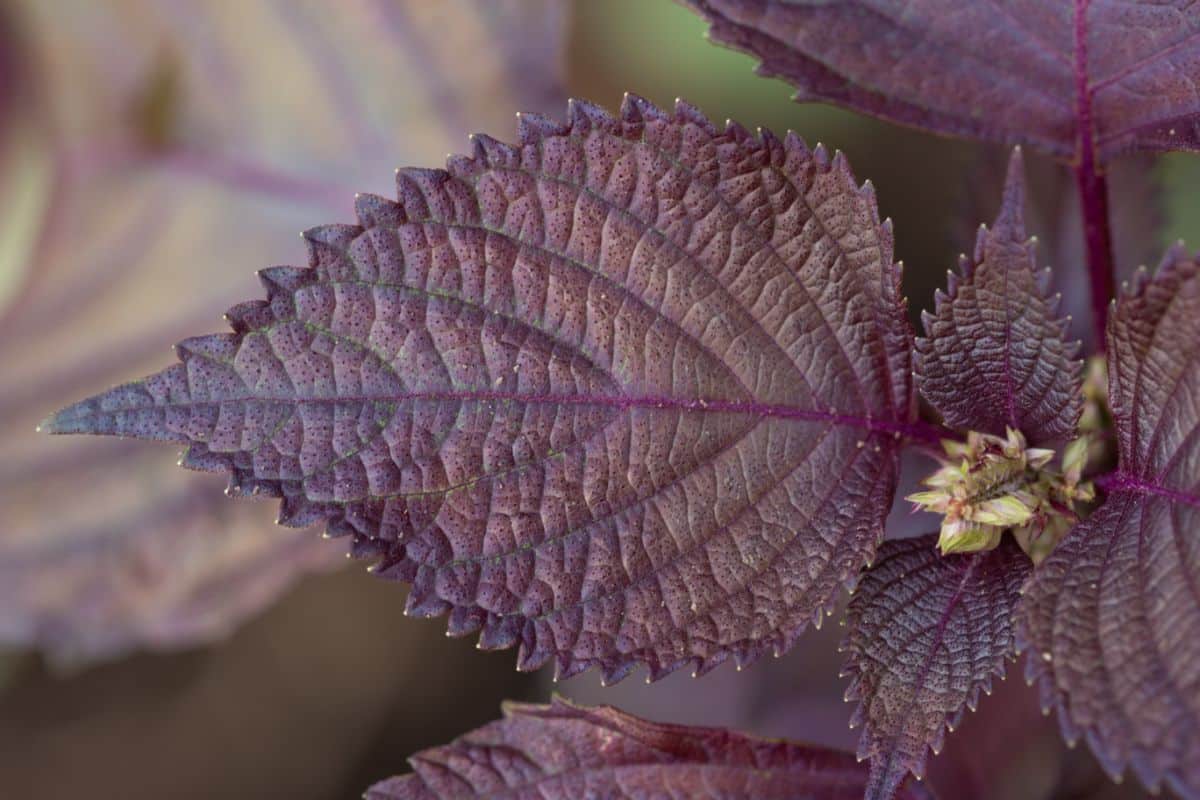
| Plant name: | Shiso |
| Light requirements: | Full sun to light shade |
| Water requirements: | Moderate |
| Dehydrator temperature setting: | 125 to 130ºF |
| Remove stems before dehydrating? | Yes |
Shiso is a less commonly grown herb in the West, but it’s commonly used in Japanese cuisine. Dried, fresh, or pickled, shiso adds a flavorful accent to sushi, noodle dishes, and salads, and it has a striking red color that can add visual interest to plate designs too! A member of the mint family, shiso is sometimes called “Japanese basil,” but it has a flavor that is more akin to mint but with a touch of cinnamon.
Shiso can be grown in garden beds or pots, but it only grows perennial in zones 10 and 11, so you’ll want to harvest your entire crop before winter. If you end up with more shiso than you can use, this herb dries well with all fast-drying methods, but it will lose its color and flavor with slow air drying. As with basil, shiso will dry quicker if you clip the leaves from the plant’s fleshy stems and dry the leaves in a single layer.
9. Celery leaves (Apium graveolens)

| Plant name: | Celery leaves |
| Light requirements: | Full sun, but benefits from light afternoon shade |
| Water requirements: | High to moderate |
| Dehydrator temperature setting: | 115 to 125ºF |
| Remove stems before dehydrating? | Yes |
Celery isn’t exactly an herb, but celery leaves are often included in spice cabinets in seasoning blends and celery salt. Most people grow celery just for the plant’s edible stalks, but celery leaves are delicious and edible, and utilizing the entire celery plant reduces food waste and helps you get more fresh produce out of your garden. Not to mention, if you save celery leaves and dry them, they can be used to make your own DIY Old Bay seasoning blend!
To dry celery leaves, clip the leaves off from the celery stalks and give them a good rinse in your kitchen sink to remove any dirt or sand. Then, spread the celery leaves out in a single layer and dehydrate them at 125ºF for about 6 to 8 hours. Test the leaves regularly to make sure they don’t dry too long, and turn off your dehydrator when the celery leaves are nice and crispy and can be crumbled with your fingers.
10. Chervil (Anthriscus cerefolium)
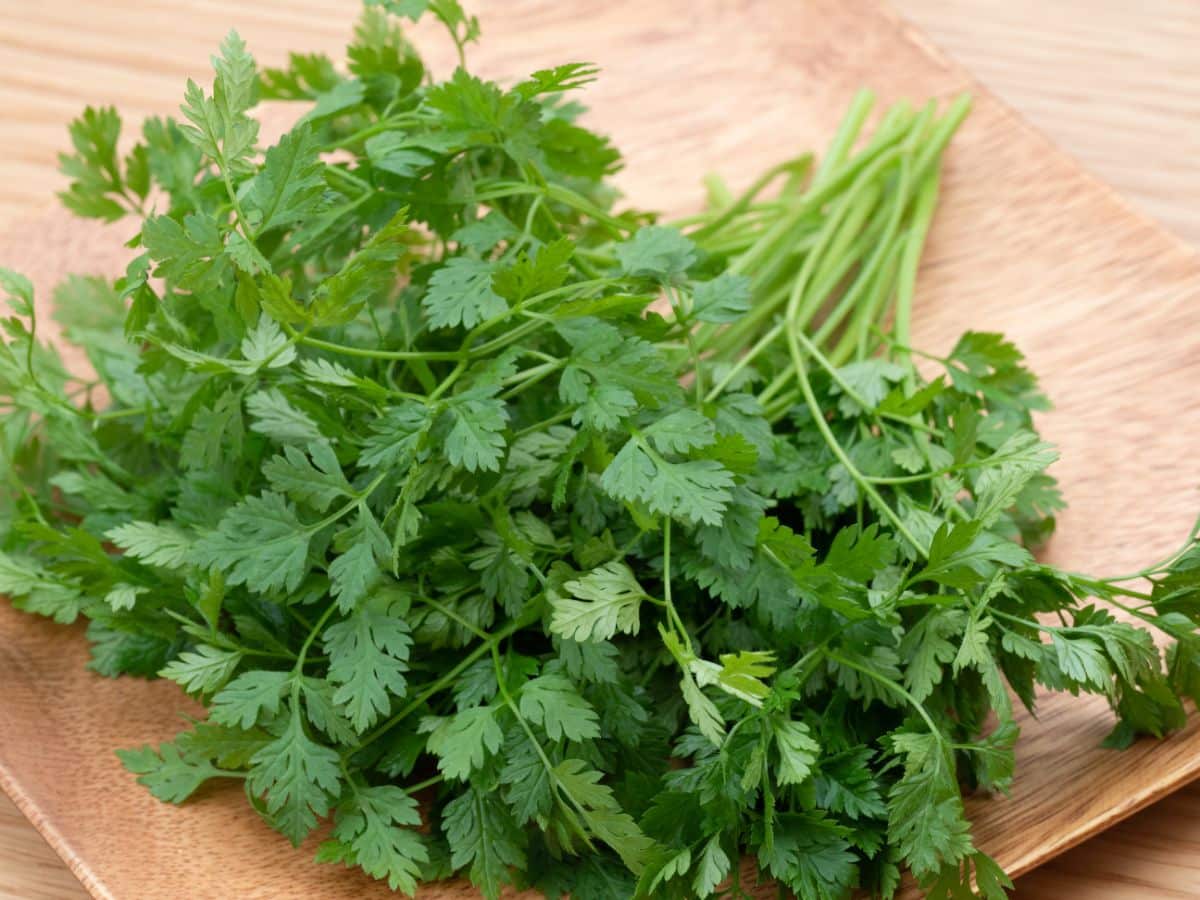
| Plant name: | Chervil |
| Light requirements: | Part shade |
| Water requirements: | High to moderate |
| Dehydrator temperature setting: | 95 to 115ºF |
| Remove stems before dehydrating? | Optional |
Like shiso, chervil is a less commonly grown herb, although it is a staple ingredient in French cuisine, and it makes a fine addition to poultry, egg, and seafood dishes. Sometimes known as “French parsley,” chervil has a delicate flavor that is reminiscent of tarragon and parsley but with a more subtle edge. Since chervil isn’t as well known as some other culinary herbs, it can be a harder plant to track down at plant nurseries, but you can easily grow chervil from seeds if needed!
Chervil can be harvested throughout the season, but it’s best to wait until the plant is at least 6” high before you start snipping off fresh chervil leaves. If you’re new to growing chervil, this plant has very similar growing needs to parsley, and it needs lots of water and plenty of sunlight. In dehydrators, chervil dries quickly, usually in just 2 to 4 hours, but you’ll want to use lower temperature settings to prevent this delicate herb from getting “overcooked.”
Frequently asked questions
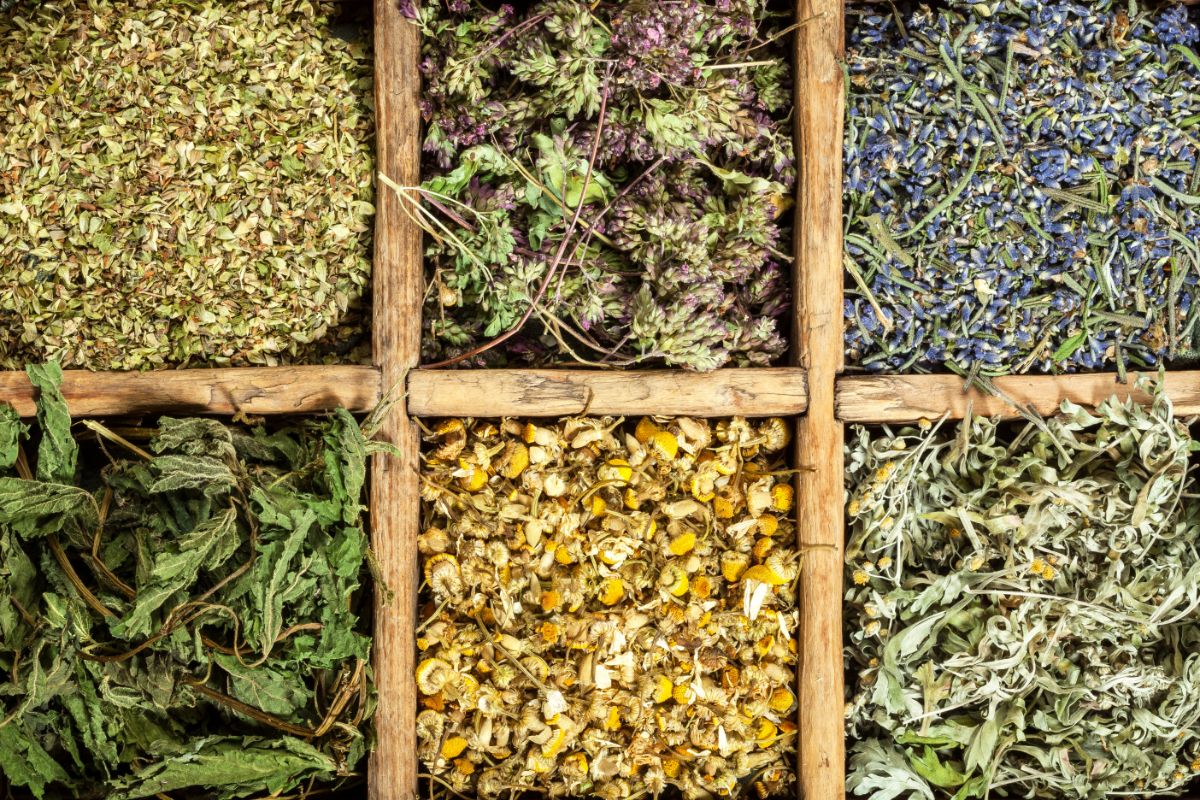
Different herbs contain different amounts of moisture, so they will need to be processed for different lengths of time. Some tender herbs can dry in just an hour or two, while others may need to be dried overnight or longer. A good rule of thumb is that your herbs are done drying when you can easily crumble them.
Air drying and dehydrators both have their pros and cons, and one isn’t necessarily better than the other. Air drying takes longer, but it conserves electricity, while dehydrators speed up the dehydration process and often produce more uniformly colored dried herbs. Herbs with tender stems tend to dry best with dehydrators, while sturdy, woody-stemmed herbs hold up well with hang drying.
Improperly stored dehydrated herbs can develop mold, which is why it’s important to make sure your herbs are completely dry before storing them in airtight containers. When properly stored, dried herbs should stay fresh for about 1 to 3 years. After this time, dried herbs may still be technically usable, but their color and flavor will begin to degrade.
Ideally yes. While you don’t necessarily need to wash herbs before dehydrating, rinsing off plant leaves before using them is always a good idea. After all, if you’re putting all that work into dehydrating homegrown herbs, you don’t want to accidentally add garden grime or sand to your spice jars!
Some herbs will naturally darken when dehydrated, but if your herbs are turning very dark, there are two possible causes. First, herbs can darken if they don’t dry quickly enough, so you may want to adjust the temperature setting on your dehydrator. Second, because herbs can also turn dark if they are dehydrated at high heat, you’ll want to take a look at your temperature setting and turn it down if you think your dehydrator is running hot.
Dried herbs maintain their freshness for about 1 to 3 years. After this time, it’s a good idea to compost your dried herbs and replenish your stock, as older herbs will begin to lose their color and flavor. Of course, if your herbs ever develop an unsavory odor, they feel wet or you notice mold developing in your spice jars, you’ll want to toss out your herbs as well.
Summary
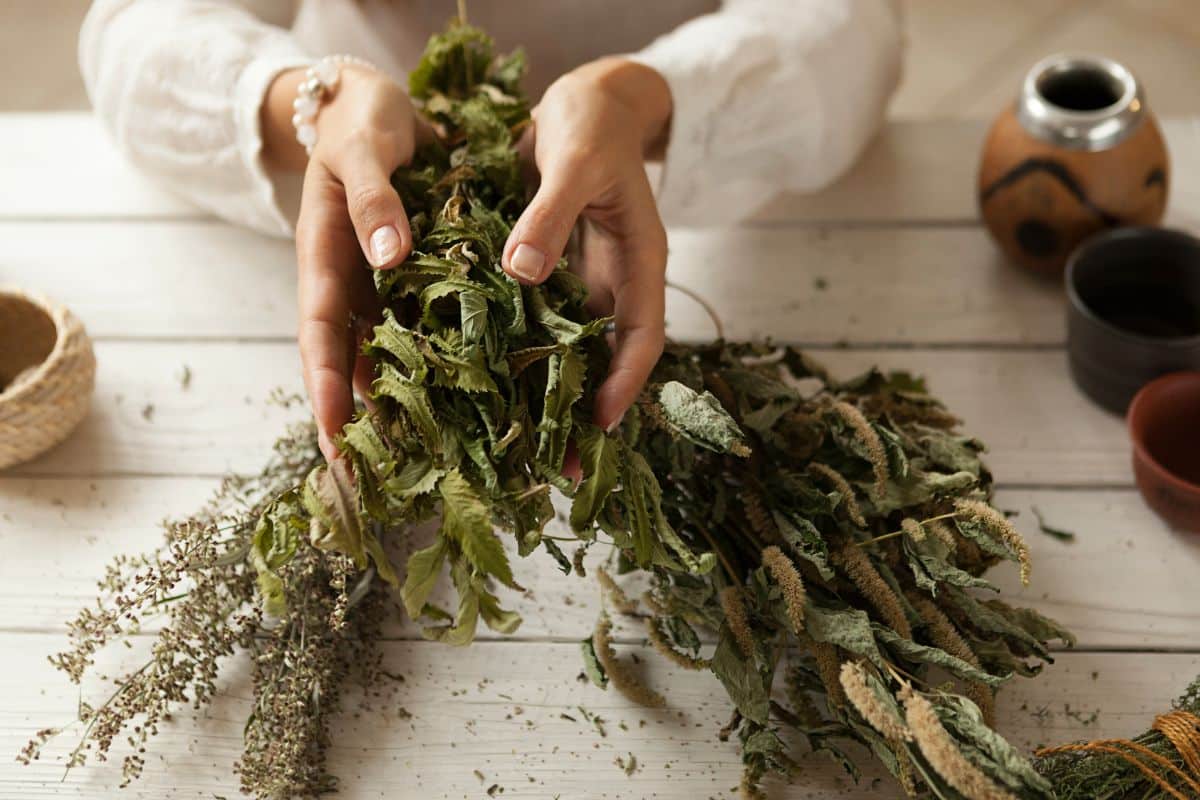
Drying herbs with a dehydrator is a quick and easy way to preserve your garden harvest and have the highest quality dried herbs on hand for your favorite recipes. While some herbs can be preserved with hang drying, herbs with tender stems maintain their color and flavor better with fast drying methods. Food dehydrators, ovens, and microwaves all work well for these herb varieties, so the real question is, which dehydration method do you find most appealing?
For more herb drying tips, check out our guide on the best herbs to preserve for herbal teas. And if the idea of preserving your harvest has inspired you, you may also enjoy our recipes for how to make lacto-fermented sauerkraut and fridge pickles with your homegrown harvest.

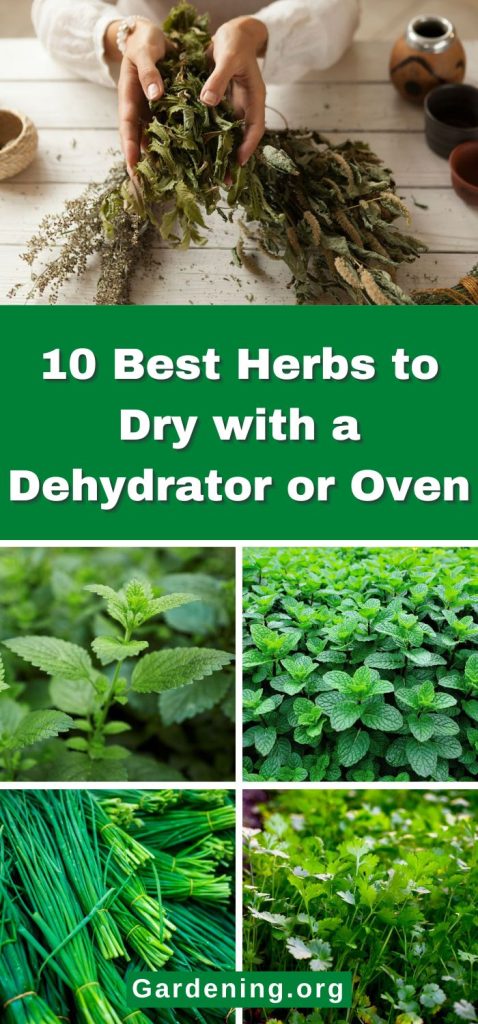
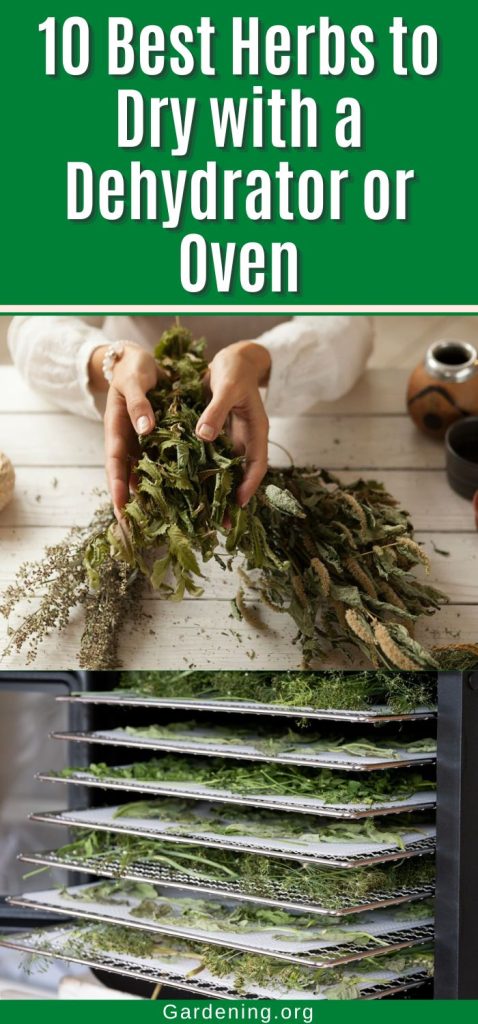
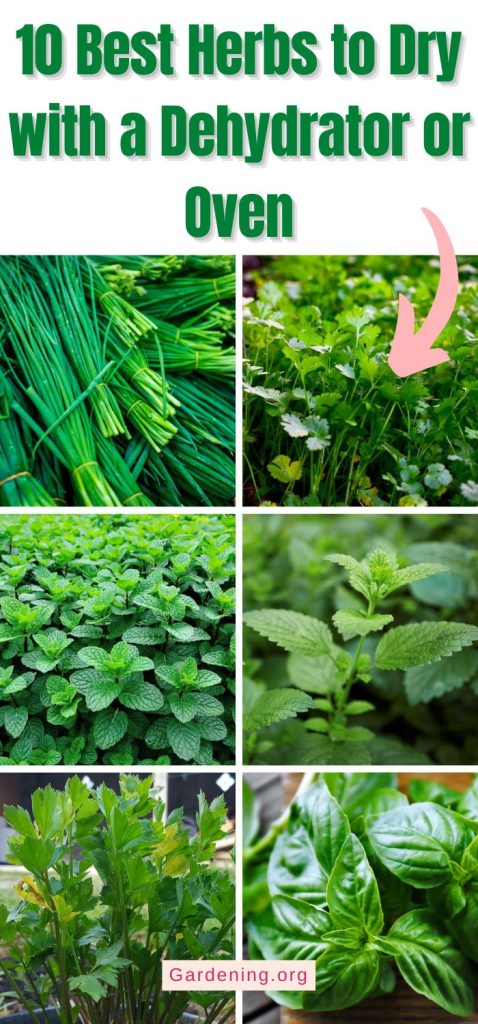

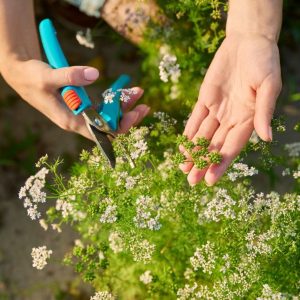
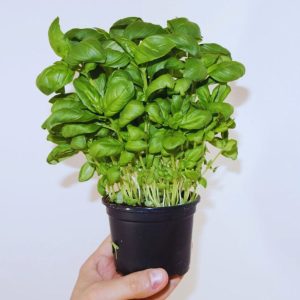
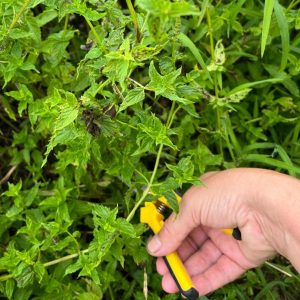

Leave a Reply